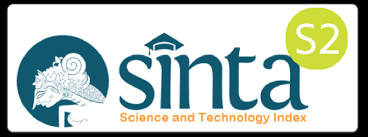Developing Learning Kit of Geometry for Vocational School Grade X Based on Multiple Intelligence Theory
Abstract
Keywords
Full Text:
PDFReferences
Bas, G., & Beyhan, O. (2010). Effects of multiple intelligences supported project-based learning on students’ achievement levels and attitudes towards English lesson. International Electronic Journal of Elementary Education,2(3). Downloaded on 30th November, 2014, from www.iejee.com/2_3_2010/365-385.pdf/.
Badan Standar Nasional Pendidikan, [National Education Standards Agency](BSNP) (2012). Laporan hasil UN SMA/MA tahun pelajaran 2011/2012, [Report on the results of the SMA / MA National Examination for the academic year 2011/2012]. Jakarta: Kementrian Pendidikan Nasional Badan Penelitian dan Pengembangan Pendidikan.
Badan Standar Nasional Pendidikan (BSNP)(2013). Laporan hasil UN SMA/MA tahun pelajaran 2012/2013. Jakarta: Kementrian Pendidikan Nasional Badan Penelitian dan Pengembangan Pendidikan.
Calik, B. & Birgili, B. (2013). Multiple Intelligence Theory for Gifted Education: Criticism and Implications. Journal for the Education of the Young Scientist and Giftedness. 1. 2147-9518. Downloaded from: https://www.researchgate.net/publication/271832916_Gifted_children's_educations_and_a_glance_to_Turkey
Carson, A. D. (2003). Why has Gardner's Theory of Multiple Intelligences had so little impact on vocational psychology? Retrieved February 21, 2008, from http://vocationalpsychology.com/essay_10_gardner.htm.
Gardner, H. (1995). Reflection on Multiple Intelligences: Myths and messages. Phi Delta Kappan. 77, 200-209. Downloaded on 20 February 2015, from http://learnweb.harvard.edu/WIDE/courses/files/reflections.pdf.
Indonesian Ministry of National Education (IMNE)(2003). Act Of The Republic Of Indonesia Number 20, Year 2003 On National Education System. Jakarta: Author. [Editor’s note: The English version of the Act as published was originally in Bahasa Indonesia in the National Gazette Number 78 Year 2003. The original text of this Act in Bahasa Indonesia is the authentic version.]
Hoerr, T. R. (2000). Becoming a multiple intelligences school. Alexandria. ASCD.
Kemendikbud. (2013). Peraturan Menteri Pendidikan dan Kebudayaan Nomor 65 Tahun 2013 tentang Standar Proses Pendidikan Dasar dan Menengah [Minister of Education and Culture Regulation Number 65 Year 2013 concerning Basic and Secondary Education Process Standards]. Jakarta: Author.
Kemendikbud. (2014). Peraturan Menteri Pendidikan dan Kebudayaan nomor 60 tahun 2014 tentang Kurikulum SMK. Jakarta: Author.
Minister Of Education And Culture Of The Republic Of Indonesia (MECRI) (2013). Regulation Of The Minister Of Education And Culture Republic Of Indonesia Number 65 of 2013, About Basic and Middle Education Process Standards. Jakarta: Author
Minister of Education and Culture of the Republic of Indonesia (MECRI) (2014). Regulation of the Minister of Education and Culture Republic of Indonesia, Number 60 of 2014. About 2013 Curriculum Middle Vocational School / Madrasah Aliyah Vocational. Jakarta: Author
Moore, K. D. (2009). Effective instructional strategies. London: SAGE Publications.
National Council of Teacher of Mathematics (2000). Principles and standards for school mathematics. Reston, VA: NCTM.
Republik Indonesia. (2003). Undang- Undang RI Nomor 20 Tahun 2003, tentang Sistem Pendidikan Nasional [RI Law Number 20 of 2003, concerning the National Education System]. Jakarta: Author.
Reynolds, C.R., Livingston, R.B., & Wilson V. (2010). Measurement and assessment in education. Upper Saddle River, New Jersey: Pearson Education, Inc.
Riyanto, Y. (2012). Paradigma Baru Pembelajaran: Sebagai referensi bagi Guru/ Pendidik dalam Implementasi Pembelajaran yang Efektif dan Berkualitas [New Learning Paradigm: As a reference for Teachers / Educators in the Implementation of Effective and Quality Learning]. Jakarta: Kencana.
Suyono & Hariyanto. (2014). Belajar dan Pembelajaran: Teori dan Konsep Dasar. Bandung: Remaja Rosdakarya [Learning and (promoting) Learning: Basic Theory and Concepts]. Bandung: PT. Remaja Rosdakarya.
Temur, O.D. (2007). The effects of teaching activities prepared according to the multiple intelligence theory on mathematics achievements and permanence of information learned by 4th grade students. International Journal of Environmental & Science Education, 4(2), 86-91.
Thiagarajan, S., Semmel, D.S, & Semmel, M.I. (1974). Instructional development for training teacher of execeptional children. Minneapolis: Indiana University.
United Nations Educational, Scientific and Cultural Organization (UNESCO)(2012). Education For All Global Monitoring Report 2012 - Youth and skills: Putting education to work. Paris: Author
Xie, J., & Lin, R. (2009). Research on multiple intelligences teaching and assessment. Asian Journal of Management and Humanity Sciences, 4(2-3), 106-124.
Yaumi, M. (2012). Pembelajaran Berbasis Multiple Intelligences [Multiple Intelligences Based Learning]. Jakarta: PT. Dian Rakyat.
DOI: https://doi.org/10.46517/seamej.v9i1.75
Refbacks
- There are currently no refbacks.
Indexed by:
Southeast Asian Mathematics Education Journal
SEAMEO Regional Centre for QITEP in Mathematics
Jl. Kaliurang Km 6, Sambisari, Condongcatur, Depok, Sleman
Yogyakarta, Indonesia
Telp. +62 274 889955
Email: seamej@qitepinmath.org
p-ISSN: 2089-4716 | e-ISSN: 2721-8546
Southeast Asian Mathematics Education Journal is licensed under a Creative Commons Attribution 4.0 International License
View My Stats
Supported by:



